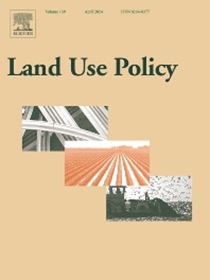Conflicts between ecological and agricultural production functions: The impact of the Grain for Green Program and wildlife damage on cropland abandonment in China’s mountainous areas
IF 5.9
1区 社会学
Q1 ENVIRONMENTAL STUDIES
引用次数: 0
Abstract
Cropland abandonment is the process by which farmers cease agricultural production, allowing land to revert to its ecological function. China’s Grain for Green Program (GGP), which aims to improve the ecological environment, and wildlife damage arising from competition for natural habitats influence farmers’ decisions to abandon croplands. However, the research findings on this topic remains both mixed and insufficient. This study develops a theoretical framework from the perspective of the conflict between ecological and agricultural production functions to explain the relationships among the GGP, wildlife damage, and cropland abandonment. Using survey data from 2397 farmers in mountainous areas of China, this study employs multiple models and heterogeneity analysis to estimate the impact of the GGP and wildlife damage on cropland abandonment. The findings reveal that the implementation of the GGP reduces cropland abandonment, whereas wildlife damage has a significant positive effect. This indicates that the financial compensation of the GGP encourages farmers to cease agricultural production, substituting for the voluntary abandonment of cropland. Furthermore, wildlife’s pursuit of habitats results in the seizure of agricultural spaces, leading to reduced agricultural production. Additionally, the GGP can amplify the impact of wildlife damage on cropland abandonment and mitigate the impact of labor migration. Wildlife damage can also influence cropland abandonment by promoting the exit of laborers from agriculture. The GGP more effectively reduces cropland abandonment among farmers with less cropland and higher income. Farmers with less cropland and lower income are more likely to abandon their cropland because of wildlife damage. Thus, to coordinate the development of multiple goals, appropriately planning the GGP, adjusting compensation strategies, and protecting farmers’ agricultural production from wildlife damage are necessary strategies.
生态与农业生产功能的冲突:退耕还林和野生动物破坏对中国山区退耕的影响
撂荒是指农民停止农业生产,使土地恢复其生态功能的过程。中国以改善生态环境为目标的退耕还林工程(GGP),以及争夺自然栖息地造成的野生动物伤害,影响了农民放弃耕地的决定。然而,关于这一主题的研究结果仍然是混杂和不足的。本研究从生态功能与农业生产功能冲突的角度构建了一个理论框架来解释GGP、野生动物破坏与撂荒之间的关系。利用2397名中国山区农民的调查数据,采用多元模型和异质性分析方法,研究了GGP和野生动物破坏对耕地撂撂率的影响。研究结果表明,实施GGP减少了耕地撂荒,而野生动物破坏具有显著的积极作用。这表明,GGP的财政补偿鼓励农民停止农业生产,代替自愿放弃耕地。此外,野生动物对栖息地的追求导致了农业空间的占用,导致农业生产的减少。此外,GGP可以放大野生动物破坏对撂荒的影响,减轻劳动力迁移的影响。野生动物的破坏也可以通过促进劳动力从农业中退出来影响耕地的放弃。GGP更有效地减少了耕地少、收入高的农民的撂荒现象。耕地较少、收入较低的农民更有可能因为野生动物的破坏而放弃耕地。因此,协调多目标发展,合理规划GGP,调整补偿策略,保护农民农业生产不受野生动物损害是必要的策略。
本文章由计算机程序翻译,如有差异,请以英文原文为准。
求助全文
约1分钟内获得全文
求助全文
来源期刊

Land Use Policy
ENVIRONMENTAL STUDIES-
CiteScore
13.70
自引率
8.50%
发文量
553
期刊介绍:
Land Use Policy is an international and interdisciplinary journal concerned with the social, economic, political, legal, physical and planning aspects of urban and rural land use.
Land Use Policy examines issues in geography, agriculture, forestry, irrigation, environmental conservation, housing, urban development and transport in both developed and developing countries through major refereed articles and shorter viewpoint pieces.
 求助内容:
求助内容: 应助结果提醒方式:
应助结果提醒方式:


